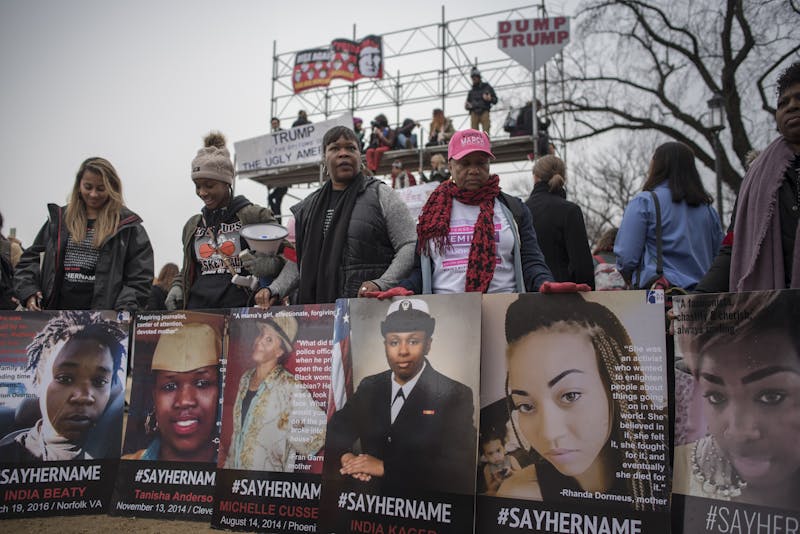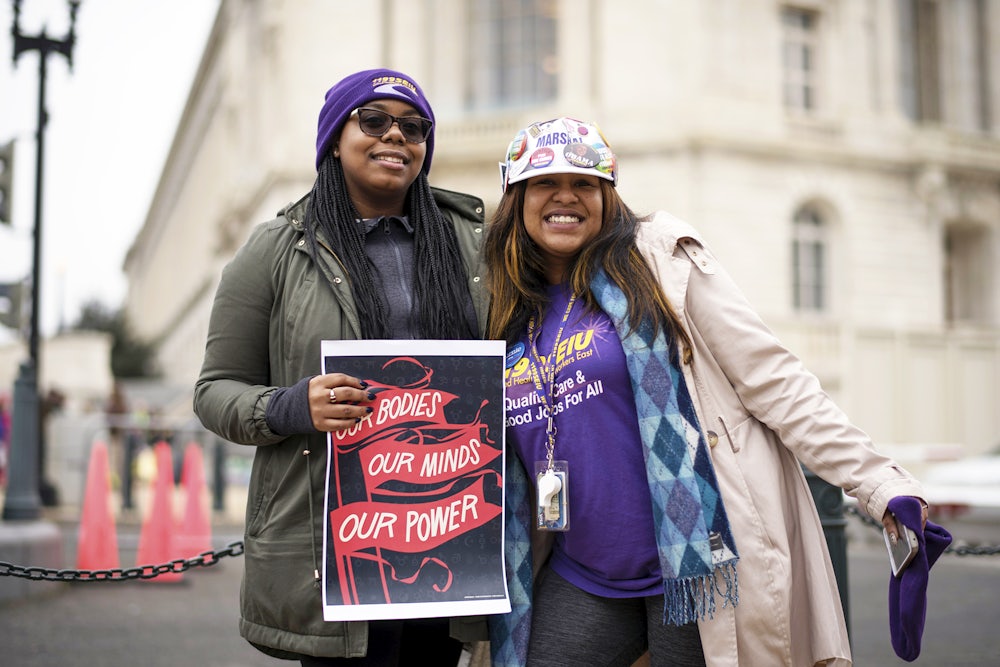The inauguration of President Donald Trump came and went in Washington, D.C., like a formal dinner left untouched by its guests, providing a canvas of neatly stacked barriers, stripped-down scaffolding, and city blocks lined with empty bleachers—ready for a crowd of half a million marchers who descended on the city the next morning, three times as many as had attended the day before. Metro stations in both the city and the surrounding suburbs were flooded with happy throngs, and conductors skipped stations when the platforms became overwhelmed with crowds. Inside the march itself, it was hard to know where to go: The planned route swiftly filled up, and organizers worked with police to shift crowds down Constitution Avenue and Pennsylvania Avenue towards the White House, the same route that, only a day before, featured a dour, drizzly procession of president and vice president waving at sparse crowds.
“Donald Trump Will Lie About This” read one sign, and, sure enough, White House Press Secretary Sean Spicer was sent out in the afternoon to falsely chide the press for reporting inaccurate numbers about the inauguration crowd, as reports came in from all over the country, and all over the world, of record-breaking protests.

Casey Johnson-Aksoy and a friend carried a sign celebrating Congresswoman Maxine Waters (D-CA), who had spoken at the rally alongside Senators Kamala Harris (D-CA), Tammy Duckworth (D-IL), and Kirsten Gillibrand (D-NY). “I needed to do something,” Johnson-Aksoy said. “I felt like I had been asleep for a long time.”


Dana Green of Alexandria, Virginia, has been attending protests since Vietnam and was impressed by the number and diversity of women at the march. “I am a feminist from in utero. This has been a very hard campaign and I believe this is going to be a long haul of resistance. I don’t want to come from a place of hating the American people, I don’t want to hate people who voted for Donald Trump. I think they were misguided. I think oligarchs rule when they can divide people, so I think the most important thing is this march.”

The Women’s March is just one of many rallies and marches Ivanna Tavarez plans to attend this year representing 1199 SEIU. “We always try to go to every rally and show our face because we believe in social justice. After this we’re going to go to the climate change march on April 29, because we need to hold Donald Trump responsible for the things he is saying and doing.”

“I was alone on election night because it felt like a private moment,” says Hallie Card, 26. “I thought I was going to tell my children that I was sitting in a blanket while watching the first woman elected president. But as I watched North Carolina and Virginia slip, I made myself stay up because I never wanted to forget how I felt in that moment. I never wanted to forget that helplessness, because that’s what is going to keep driving me to call my representatives. To feel so close to something—something my boyfriend or my dad or my brother can’t understand—that was going to mean so much for so many women, and to have the rug pulled out from under you, I’ll never forget it for all my days. It will be a pivotal moment for all my life, the moment that galvanized my political interests.”

Frances Garrett attended the protests during the inauguration the day before with her group Say Her Name, which raises awareness for black women killed by the police. “Yesterday was a hostile environment. I have never experienced anything like it. I was here eight years ago and it was totally different. It was love, it was positive energy. Yesterday it was so negative, there was a lot of anxiety. Today, I’m feeling hopeful. I’m looking at all of these people and I think, ants can move mountains.”

Kathleen Anderson, who traveled to the march with two friends from the Catskills, encountered President Trump’s business dealings as an artist working in a New Haven studio in the mid-1980s. “My landlord owned the building, he had a furniture manufacturing business and he was hired by Trump to design and manufacture hundreds of pieces of furniture for one of his hotels or casinos. I was hired to do all of the gold leafing on this furniture, and while I got paid for the work I did, and my landlord paid all of his workers, he himself never got paid. He lost his building and he lost his business. Even then we were saying Trump is evil. Now I can’t believe he is our president.”


